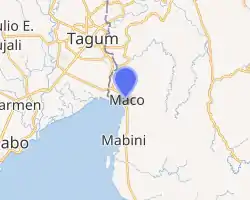Maco, Davao de Oro
Maco, officially the Municipality of Maco (Cebuano: Lungsod sa Maco; Tagalog: Bayan ng Maco), is a 1st class municipality in the province of Davao de Oro, Philippines. According to the 2015 census, it has a population of 81,277 people. [3]
Maco | |
|---|---|
| Municipality of Maco | |
 Map of Davao de Oro with Maco highlighted | |
OpenStreetMap 
| |
.svg.png.webp) Maco Location within the Philippines | |
| Coordinates: 7°21′43″N 125°51′19″E | |
| Country | |
| Region | Davao Region |
| Province | Davao de Oro |
| District | 2nd District |
| Founded | June 17, 1967 |
| Barangays | 37 (see Barangays) |
| Government | |
| • Type | Sangguniang Bayan |
| • Mayor | Alvera Veronica R. Rimando-Arancon |
| • Vice Mayor | Arthur Carlos Voltaire R. Rimando |
| • Representative | Ruwel Peter S. Gonzaga |
| • Electorate | 51,700 voters (2019) |
| Area | |
| • Total | 342.23 km2 (132.14 sq mi) |
| Elevation | 114 m (374 ft) |
| Population | |
| • Total | 81,277 |
| • Density | 240/km2 (620/sq mi) |
| • Households | 18,666 |
| Economy | |
| • Income class | 1st municipal income class |
| • Poverty incidence | 23.27% (2015)[4] |
| • Revenue | ₱269,287,164.02 (2016) |
| Time zone | UTC+8 (PST) |
| ZIP code | 8806 |
| PSGC | |
| IDD : area code | +63 (0)87 |
| Climate type | tropical rainforest climate |
| Native languages | Davawenyo Cebuano Kalagan Mansaka Tagalog Ata Manobo |
| Website | www |
It was formerly part of the Municipality of Mabini before becoming an independent municipality on June 17, 1967.[5]
Barangays
Maco is politically subdivided into 37 barangays. [2]
- Anibongan
- Anislagan
- Binuangan
- Bucana
- Calabcab
- Concepcion
- Dumlan
- Elizalde (Somil)
- Pangi (Gaudencio Antonio)
- Gubatan
- Hijo
- Kinuban
- Langgam
- Lapu-lapu
- Libay-libay
- Limbo
- Lumatab
- Magangit
- Malamodao
- Manipongol
- Mapaang
- Masara
- New Asturias
- Panibasan
- Panoraon
- Poblacion
- San Juan
- San Roque
- Sangab
- Taglawig
- Mainit
- New Barili
- New Leyte
- New Visayas
- Panangan
- Tagbaros
- Teresa
Climate
| Climate data for Maco | |||||||||||||
|---|---|---|---|---|---|---|---|---|---|---|---|---|---|
| Month | Jan | Feb | Mar | Apr | May | Jun | Jul | Aug | Sep | Oct | Nov | Dec | Year |
| Average high °C (°F) | 29 (84) |
30 (86) |
30 (86) |
31 (88) |
31 (88) |
30 (86) |
30 (86) |
30 (86) |
30 (86) |
30 (86) |
30 (86) |
30 (86) |
30 (86) |
| Average low °C (°F) | 22 (72) |
22 (72) |
22 (72) |
23 (73) |
24 (75) |
24 (75) |
24 (75) |
24 (75) |
24 (75) |
24 (75) |
23 (73) |
22 (72) |
23 (74) |
| Average precipitation mm (inches) | 98 (3.9) |
86 (3.4) |
91 (3.6) |
83 (3.3) |
133 (5.2) |
158 (6.2) |
111 (4.4) |
101 (4.0) |
94 (3.7) |
117 (4.6) |
131 (5.2) |
94 (3.7) |
1,297 (51.2) |
| Average rainy days | 16.4 | 14.3 | 16.3 | 18.5 | 25.3 | 25.0 | 23.8 | 21.9 | 20.8 | 24.4 | 24.3 | 18.7 | 249.7 |
| Source: Meteoblue [6] | |||||||||||||
Demographics
| Year | Pop. | ±% p.a. |
|---|---|---|
| 1970 | 29,693 | — |
| 1975 | 32,562 | +1.87% |
| 1980 | 41,017 | +4.72% |
| 1990 | 55,991 | +3.16% |
| 1995 | 58,609 | +0.86% |
| 2000 | 65,181 | +2.30% |
| 2007 | 70,906 | +1.17% |
| 2010 | 72,235 | +0.68% |
| 2015 | 81,277 | +2.27% |
| Source: Philippine Statistics Authority [3] [7] [8][9] | ||
In the 2015 census, the population of Maco, Davao de Oro, was 81,277 people, [3] with a density of 240 inhabitants per square kilometre or 620 inhabitants per square mile.
Festivals and events
- Fiesta ng Maco
- is celebrated every last Saturday of the month of June honoring "Inahan sa Kanunay'ng Panabang" (Mother of Perpetual Help).
References
- Municipality of Maco | (DILG)
- "Province: Compostela Valley". PSGC Interactive. Quezon City, Philippines: Philippine Statistics Authority. Retrieved 12 November 2016.
- Census of Population (2015). "Region XI (Davao Region)". Total Population by Province, City, Municipality and Barangay. PSA. Retrieved 20 June 2016.
- "PSA releases the 2015 Municipal and City Level Poverty Estimates". Quezon City, Philippines. Retrieved 12 October 2019.
- "Executive Order No. 128: Creating the Municipality of Maco in the Province of Davao" (PDF). Official Gazette of the Republic of the Philippines. Retrieved 21 April 2014.
- "Maco: Average Temperatures and Rainfall". Meteoblue. Retrieved 16 November 2019.
- Census of Population and Housing (2010). "Region XI (Davao Region)". Total Population by Province, City, Municipality and Barangay. NSO. Retrieved 29 June 2016.
- Censuses of Population (1903–2007). "Region XI (Davao Region)". Table 1. Population Enumerated in Various Censuses by Province/Highly Urbanized City: 1903 to 2007. NSO.
- "Province of Compostela Valley". Municipality Population Data. Local Water Utilities Administration Research Division. Retrieved 17 December 2016.
- "Events and Festivals: June". Philippine Department of Tourism. Archived from the original on 28 April 2014. Retrieved 21 April 2014.
External links
This article is issued from Wikipedia. The text is licensed under Creative Commons - Attribution - Sharealike. Additional terms may apply for the media files.
